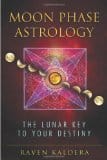 Moon Phase Astrology, by Raven Kaldera
Moon Phase Astrology, by Raven Kaldera
Destiny Books, 9781594774010, 354pp., 2011
It’s always nice to see an astrology book that isn’t simply another introductory rehash. In Moon Phase Astrology, Raven Kaldera decides to narrow the focus of the book to just the Moon.
The book has the necessary section on how to find out what phase your moon is in, and the difference between the astronomical, astrological, and natural methods of calculating the moon phases. An issue pops up here though, for when discussing the rulerships of the signs not even a mention is given to classical attributions, only the modern are worked with in this text. To spend an entire book on the Moon Kaldera explores the eight phases and twelve Zodiac signs, meaning there are 96 different moons to work with.
Each moon is described as part of an ongoing story of life, the descriptions border on vague, though not overly so. Kaldera tells the story of each moon, what leads them to be a certain way, what has inspired them or damaged them, and eventually leads into a discussion of the personality associated with the moon. It’s interesting to see the cycles Kaldera weaves between all the phases in the same sign, and all the phases in a single sign.
Personally, despite the great title, I found the Heretic Moon had no resonances with me, and I could have been fine with that, but Kaldera expands the system beyond a simple 1 in 96 moons. You don’t just have your natal moon to work with, but various other moons decided upon by what seem to be arbitrary rules: If your moon is conjunct a planet also read it as if the moon was in the sign ruled by that planet, if your moon is in any major aspect with a planet read your moon in the same sign but a different phase, if your moon is in any major aspect with a planet also read your moon in a different phase and the sign ruled by that planet, and lastly do all of the above with planets transiting your natal moon.
With my chart as an example, I go from 1 in 96 moons to 7 out of 96 moons, and grabbing a few charts of friends as examples most people end up with 8 to 12 moons with this method. It’s not just that it seems arbitrary in the rulings, but by having so much backtracking and additional moons the chances that one of the vague descriptions will fit you is greatly increased. I would have been happier if the book was simply wrong about me, but by looking up 6 additional moons out of a pool of 96 the idea that anything of use is contained in the different moons becomes stretched thin. The moons may work out better for other people, but I had a lot of trouble applying Kaldera’s views to my life.
In the end I wasn’t impressed with this book, I had hopes for a book that decided to focus on the Moon alone, but the book came across as cluttered, with a ridiculous amount of “shadow” moons. Any chance for accuracy or insight was obscured by too many possibilities, which felt like hedging bets.








